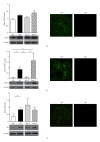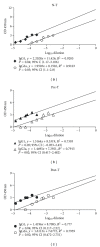Ferulic Acid, an Angelica sinensis-Derived Polyphenol, Slows the Progression of Membranous Nephropathy in a Mouse Model
- PMID: 22844329
- PMCID: PMC3403610
- DOI: 10.1155/2012/161235
Ferulic Acid, an Angelica sinensis-Derived Polyphenol, Slows the Progression of Membranous Nephropathy in a Mouse Model
Erratum in
-
Corrigendum to "Ferulic Acid, an Angelica sinensis-Derived Polyphenol, Slows the Progression of Membranous Nephropathy in a Mouse Model".Evid Based Complement Alternat Med. 2016;2016:7315875. doi: 10.1155/2016/7315875. Epub 2016 May 24. Evid Based Complement Alternat Med. 2016. PMID: 27313652 Free PMC article.
Abstract
Membranous nephropathy (MN) is a leading cause of adult nephrotic syndrome but lacks adequate treatment. Different extracts of Angelica sinensis (AS) and one of its active compounds, ferulic acid (FA), were used to evaluate the therapeutic effects in a MN mouse model. The MN model was grouped into three subgroups: no treatment (N-T), treatment at induction of MN (Pre-T), and treatment after full-blown MN (Post-T). The results showed that the methanol (ME) layer of AS extract exhibited a therapeutic effect on MN-induced proteinuria. The ME layer-enriched compound, FA, improved the hypoalbuminemia, hyperlipidemia, and proteinuria in both Pre-T and Post-T groups. Ferulic acid also reduced the formation of oxidative protein products and increased the synthesis of antioxidant enzymes in groups Pre-T and Post-T. Regarding angiogenesis factors, the antiangiogenic factors in renal glomeruli were increased in group N-T, but, after FA treatment, only one of the antiangiogenic factors, thrombospondin-1, showed a significant decrease. Furthermore, the expression of Th2 predominant showed significant decrease in both Pre-T and Post-T groups when compared to that of N-T group. In summary, FA retarded the progression of MN, and the mechanisms involved the regulation of oxidative stresses, angiogenic and antiangiogenic factors, and attenuation of Th2 response.
Figures






References
-
- Oliveira DBG. Membranous nephropathy: an IgG4-mediated disease. The Lancet. 1998;351(9103):670–671. - PubMed
-
- Ferraz FH, Martins CG, Cavalcanti JC, et al. Profile of glomerular diseases in a public hospital of Federal District, Brazil. Jornal Brasileiro de Nefrologia. 2010;32(3):249–256. - PubMed
-
- Massry SG, Glassock RJ. Massry & Glassock's Textbook of Nephrology. Baltimore, Md, USA: Williams & Wilkins; 1995.
-
- Kerjaschki D, Neale TJ. Molecular mechanisms of glomerular injury in rat experimental membranous nephropathy (Heymann nephritis) Journal of the American Society of Nephrology. 1996;7(12):2518–2526. - PubMed
LinkOut - more resources
Full Text Sources
Research Materials

